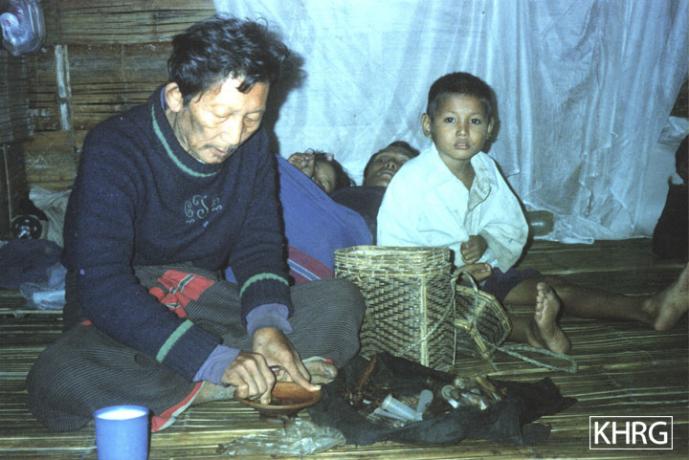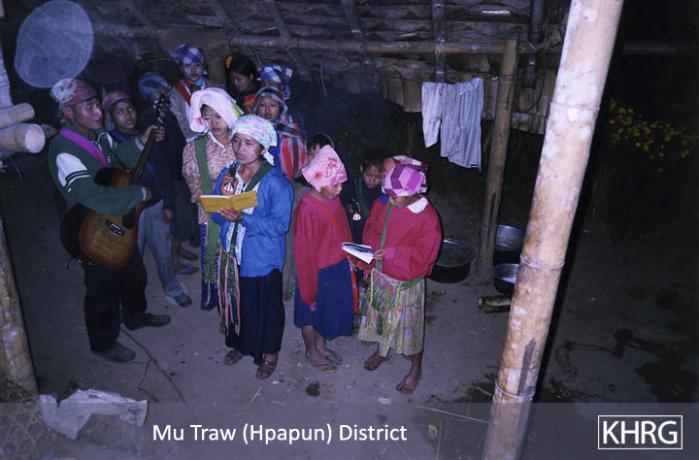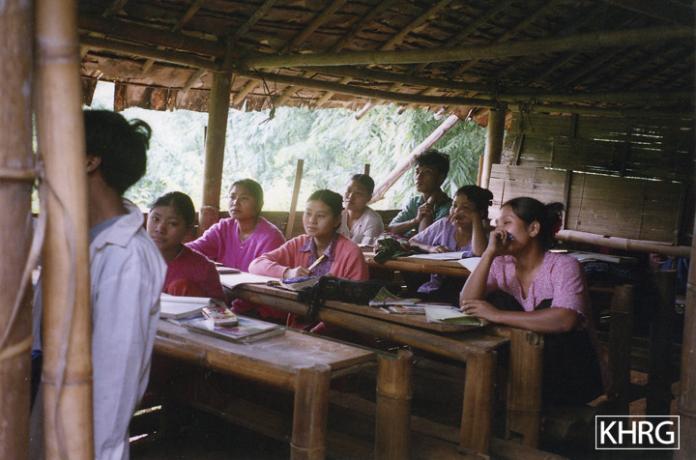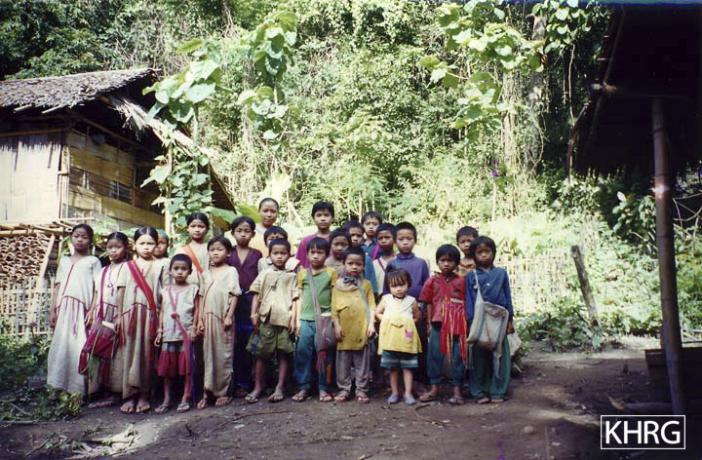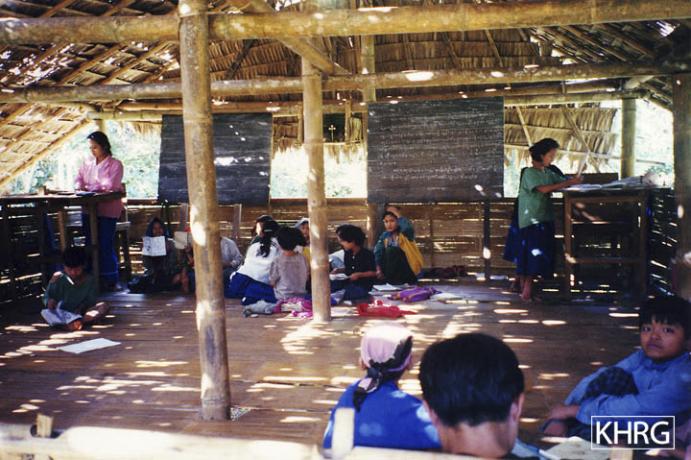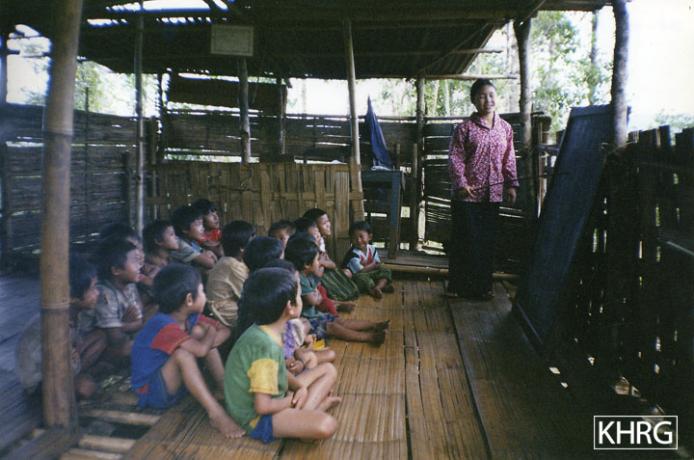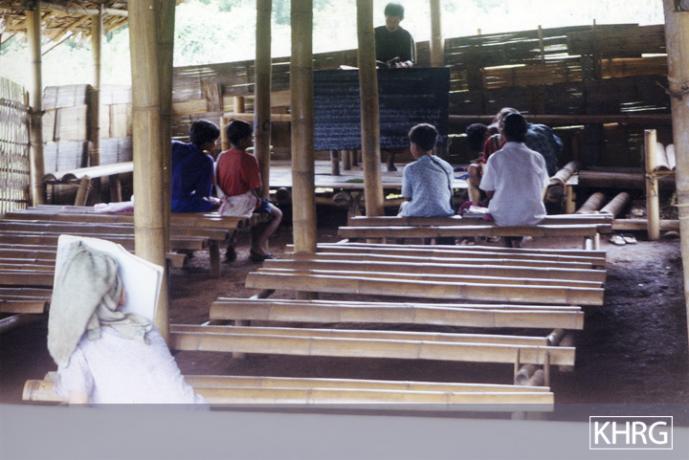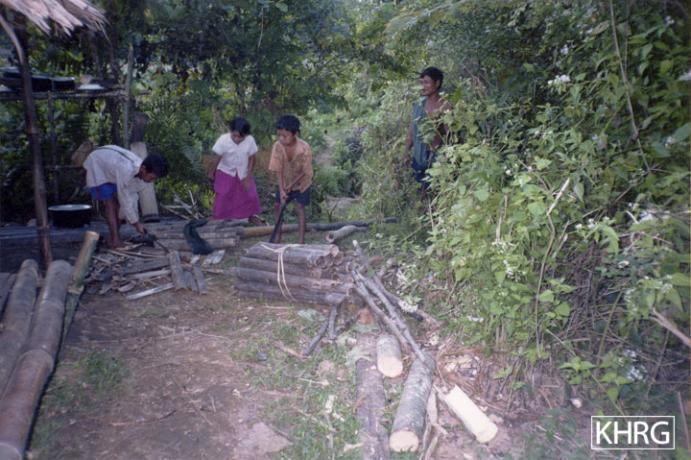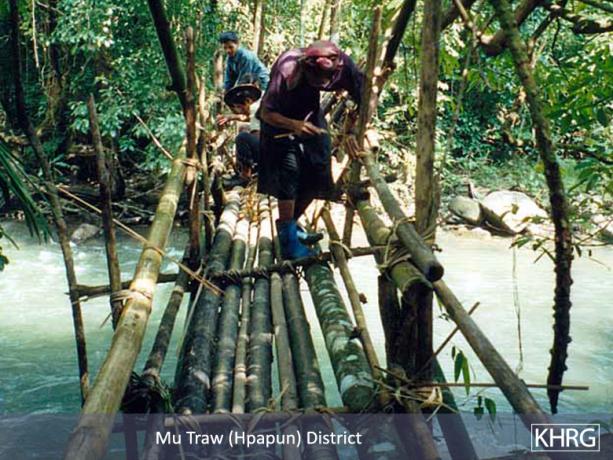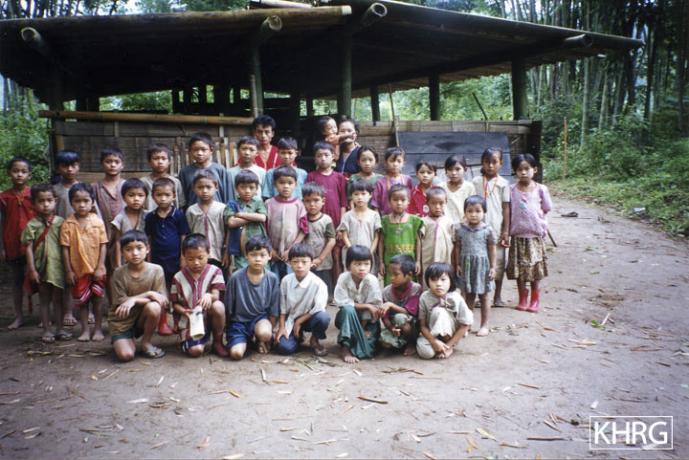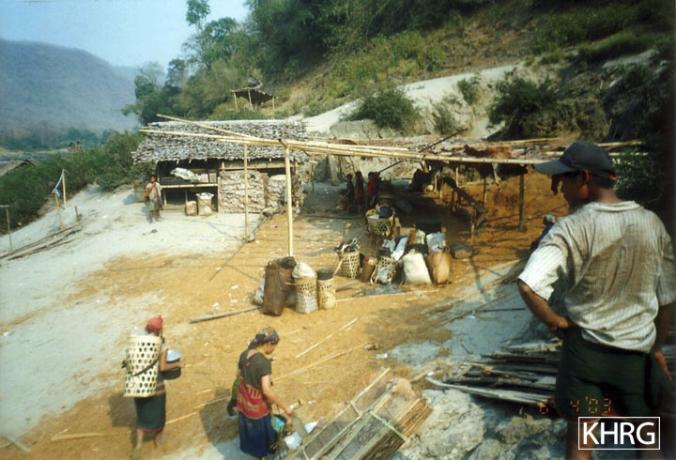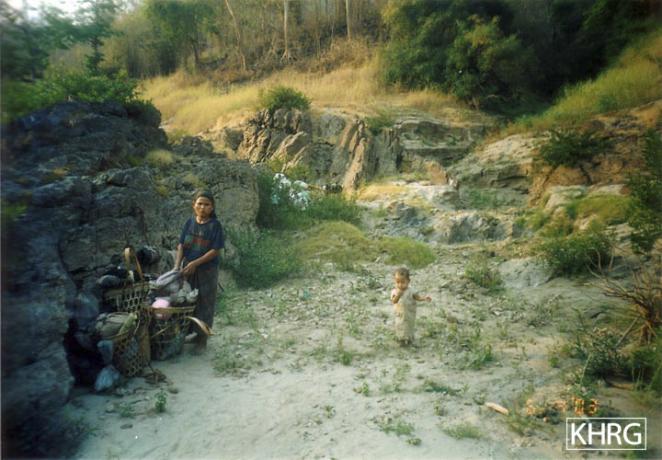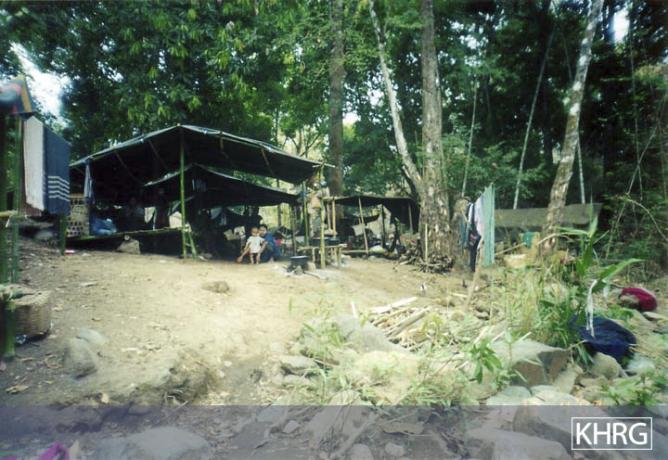Photo #8-13: Naw S---, age 29, is from K--- village in Lu Thaw township, Papun district. In January 2004, SPDC troops from IB #60 found her living in hiding in the forest. They arrested her and took her and her three children to their camp at Pwa Ghaw. She was heavily pregnant, but the soldiers gave her and her children no food or rest along the way or when they reached the camp. Village elders of the nearby SPDC-controlled village of Pwa Ghaw managed to have her released and gave her rice, water, and clothing, but she had a miscarriage and almost died. She stayed with the villagers for 7 days, and then they took her back to the place where her husband was staying. Living back in the jungle without medicines, she fell ill and two of her three children got sick and died. She then fled to Thailand with her only remaining child, and arrived in February 2004 at the refugee camp where this photo was taken. The artwork behind her, depicting peaceful village life, was done by children in the refugee camp. [Photo: KHRG researcher]
Photo #8-14: Naw T--- fled SPDC troops around her village in Tantabin township, Toungoo district and now lives in this shelter in the forest. When this photo was taken in February 2004 she had fallen seriously ill. There were no mobile medical teams in the area, so she had no access to treatment. [Photo: KHRG researcher]
Photo #8-15: Saw A--- and Naw W--- were fleeing an SPDC column in Lu Thaw township, Papun district when their baby was born in the jungle on January 6 th 2004. This photo was taken two days later. [Photo: KHRG researcher]
Photo #10-143: Internally displaced villagers from all around gathered at this forest clearing in Lu Thaw township, Papun district on January 7 th 2004 to receive treatment from Karen medics. To the left, villagers are awaiting diagnosis. In the centre is the 'intensive care unit', where those on intravenous drips lie on a bed of rice straw. Photos #10-144, 10-145: Internally displaced villagers who are ill in the forests of Toungoo district in January 2004 ( photo 10-144 ) and Papun district in March 2004 ( photo 10-145 ) receive medical care from Karen mobile medical teams. [Photos: KHRG researchers]
Photo #10-146: When her husband fell ill and died for lack of medicine, Naw P--- was left alone to care for her 4 children, aged 3, 6, 8, and 10 when this photo was taken in October 2003. They were living as internally displaced people because they no longer dared stay in their village in Lu Thaw township, Papun district. [Photo: KHRG researcher]
Photo #9-24: In July 2003, 16 year old Naw M--- was working at her farmfield hut when KNLA soldiers warned her that SPDC troops were coming that way, so she ran back toward her village but sliced her leg open on the way. There is no medical help at her village and the KNLA soldiers had no medicine, so this photo shows one of them cleaning her wound, applying tobacco juice to keep out infection and insects, and binding it with a cloth. Photo #8-16: In mid-2003, Naw Y--- in T--- village, Lu Thaw township, Papun district, developed a bone abscess. There are no medics in her village, so she went to Papun hospital for treatment. The doctors there demanded 100,000 Kyat for the treatment, but she couldn't pay so she returned to the village. When this photo was taken on June 20 th 2003, she had still not had any treatment. [Photo: KHRG researcher]
Photo #8-17: Naw H---, 28, from B--- village in Bu Tho township, Papun district, was about to give birth when SPDC LIB #434 troops came to her village on January 15 th 2003. She had to flee to this hillfield hut away from the village, where she immediately gave birth. This photo was taken three days later when she had made a fire to keep warm. [Photo: KHRG researcher]
Photos # 11-48, 11-49: Saw K---, 38 years old from T--- village in Lu Thaw township, Papun District. On June 8 th 2002 he stepped on an SPDC landmine planted by Light Infantry Division #101 in the forest near D--- village. He was never able to receive proper treatment or medicine, so when this photo was taken in January 2003 his wounds had still not properly healed. [Photos: KHRG researcher]
Photo #10-147: Saw S--- from K--- village, Dweh Loh township, Papun district was forced to go as a porter for SPDC LIB #2 Column 1 (Major Tin Htun commanding) in 2002. On his return home he was continually sick. His spleen was swollen and he couldn't work. [Photo: KHRG researcher]
Photo #8-20: Naw Baw Kyaw, age 40, fled her village in 2002 because of SPDC abuses and their destruction of villages in Lu Thaw township, Papun district. Living in the forest, she fell sick and there was no medicine, so she died on September 23 rd 2002. [Photo: KHRG researcher]
Photo #10-148: Naw W---, 40, and her 15-year-old son Saw P--- in their house in T--- village, Bu Tho township, Papun district. On August 15 th 2002, a column of LIB #9 led by deputy battalion commander Myo Myint came into their village. Everyone else fled, but because Saw P--- cannot walk he and his mother had to stay alone and face the soldiers. Fortunately the soldiers did nothing to them, but when this photo was taken two weeks later they were still alone in the village. [Photo: KHRG researcher]
Photos #10-149, 10-150: Members of 'backpack' medical teams operating covertly in Karen areas gather villagers to meetings to talk about health and to treat the sick in Pa'an District in mid-November 2002. Photos #10-151, 10-152, 10-153: Medics from mobile medical teams treat internally displaced villagers in the forests of Pa'an District covertly in November 2002. [Photos: KHRG researcher]
Photos #8-24, 8-25: In mid-2002, SPDC IB #78 (Battalion commander Myo Hlaing commanding) gave the people of Tee Law P'Leh village, Kya In township, Dooplaya district, only 4 days to move to Lay Wah Ka. Eight families comprising 33 people fled to Thailand instead. Naw S--- ( photo 8-24 ) gave birth in the jungle along the way. She and the others were dependent on Saw K---, 74, a traditional herbalist ( photo 8-25 ), to keep them going when they and their children got sick. Saw K--- is shown here preparing medicine. [Photos: KHRG researcher]
Photo #9-25: Saw H--- is an 11 year old orphan from P--- village, Papun District. Both of his parents died of illness because they were unable to obtain any medicines or medical help. He now stays with his uncle. The SPDC blocks medicines from getting into this part of Papun district, and most international humanitarian agencies (including those claiming 'humanitarian neutrality' and those claiming to operate 'without borders') refuse to send aid into areas not controlled by the SPDC. This photo was taken in July 2002. [Photo: KHRG researcher]
Photo #11-47: On June 21 st 2002, an SPDC unit found the IDP hiding site at L--- in Shwegyin township, Nyaunglebin District, sending the villagers fleeing deeper into the forest. They left later that same day, but not before planting a number of landmines in and around the site. The following day, 35 year old Saw Lweh Po stepped on one of these landmines while trying to catch some fish for his wife and four day old baby in a nearby stream. His two companions who were with him at the time carried him back to the IDP site, but were unable to treat him as they had no medicine. They put him in this hammock slung from a bamboo pole and carried him eastward through the hills for five days to a KNU clinic, where this photo was taken on the afternoon of June 29 th , 2002. He died two days later. [Photo: KHRG researcher]
Photo #5-77: Saw S---, 46, from T--- in Toungoo District. He was shot in the arm by soldiers of SPDC IB #20 Column 3 without warning or provocation on March 27, 1993. He was staying in his farmfield hut when the soldiers saw him and opened fire. His arm has never fully healed; even a full decade after the incident when this photo was taken in February 2003, he still requires a bandage and sling. Since the shooting he has had great difficulty in performing his daily tasks as a hill field farmer. [Photo: KHRG researcher]
Photos # 10-154, 10-155, 10-156: Schoolteachers and students from S--- village middle school in Toungoo district. On December 18 th 2004, a column from SPDC LIB #590 (Battalion Commander Ko Ko Oo commanding) based at Tha Aye Hta marched through several villages in the area, so the villagers fled to the forest around B---. Photo 10-154 shows local schoolteachers planning how they can teach in hiding in the forest. Photo 10-155 shows middle school students preparing their lessons, and photo 10-156 shows them eating together beside their makeshift sleeping shelter. Continuing school activities is one way Karen displaced people retain dignity and community while on the move. Photos #1-52, 1-53, 1-54, 1-55: The primary schools in Khaw Hta and Yah Aw villages, Nyaunglebin district, were among the buildings burned by SPDC troops from LIB #589 and LIB #350 at the start of December 2004. Photo 1-52 shows the remains of Khaw Hta school a few days after it was burned. The people of both villages fled into the forest, where within a few days the schoolteachers had set up makeshift blackboards ( photo 1-53 ) and students from both villages tried to continue learning ( photos 1-54 and 1-55 ). [Photos: KHRG researcher]
Photos #1-56, 1-57, 1-58: Naw P---, 60 ( photo 1-56 ) is a schoolteacher in K--- village in Nyaunglebin district, and photos 1-57 and 1-58 show two of her pupils. Their village and their school were burned by SPDC troops in late November 2004, and when these photos were taken in mid-December they were living on the ground in the forest where Naw P--- was still trying to teach. [Photos: KHRG researcher]
Photos #10-157, 10-158: Students in two villages in western Papun District sing by night in the days leading up to Christmas 2004. Both of these schools lack books, pens, and material support for the teachers and they regularly have to flee mobile SPDC patrols based nearby, but schooling (and singing) continue whenever possible. [Photos: KHRG researcher]
Photos # 10-7, 10-8, 10-9, 10-10, 10-11: Internally displaced villagers in eastern Toungoo district, September 2004. These people fled villages near the Toungoo-Mawchi vehicle road near the Karen/Kayah State border due to the heavy SPDC military presence along the road. Naw M---, age 31 ( photo 10-8 ) lost her husband when he was arrested and killed by SPDC IB #26. Naw S---, age 19 ( photo 10-9 ), fled after troops from Light Infantry Division 55 burned her village. The photos show the area in the forest where they now stay in makeshift shelters. Photos 10-10 and 10-11 show the makeshift primary school they have established for their children in a nearby farmfield hut. Establishing makeshift schools is often one of the first priorities of displaced villagers because it maintains a sense of dignity, community and continuity. [Photos: KHRG researcher]
Photo #9-26: A primary school set up by internally displaced villagers for their children in the forest where they are hiding near H--- in Tantabin township, Toungoo district. This photo was taken in August 2004. Photos #9-27, 9-28: This high school (9 th and 10 th Standards) for internally displaced students was set up by the people of several villages in K--- area of Tantabin township, Toungoo district with help from the KNU. It is extremely rare for internally displaced villagers to have access to any education beyond primary school. However, this school is close to an SPDC Army camp, so it regularly has to close when SPDC patrols are active, and the students have to return to their hiding sites. These photos were taken in August 2004. Photo #9-29: Students of a newly opened primary school for internally displaced villagers in H--- village, Dweh Loh township, Papun District in July 2003. The students do not have enough books or pencils. They were unable to open the school sooner because they were unable to find any teachers. Whenever the SPDC Army troops come close to where they have set up the school in the forest, the students must flee back to their homes. Should the soldiers come closer, they have to desert their homes and flee deeper into the forest. Photo #9-30: On April 5 th 2002, SPDC IB #83 Column #1 (Column Commander Win Kyaw Oo commanding) ordered all villagers in P--- village to relocate to an SPDC relocation site at K'Lay Kee, a road junction on the vehicle road from Kya In Seik Gyi to Kyaikdon ( see map ) in Kya In township, Dooplaya District. There was no school in the relocation site where the children could learn. In 2003, some of the villagers fled the relocation site when they could no longer endure the forced labour and other SPDC demands. They resettled in their old village, built a small school and hired a teacher from a neighbouring village. The poverty caused by the forced relocation is reflected in the lack of footwear on most of the pupils, and the nakedness and distended stomachs of two of the students on the right. Regardless, education is seen as a priority by the villagers. Photo #9-31: This school in P--- village of Bu Tho township, Papun District must close whenever they receive word of an approaching SPDC Army column. If the soldiers were to see them, they would very likely be either shot on sight or arrested and forcibly relocated to an SPDC relocation site. Columns frequently burn schools like this in a deliberate attempt to erode village solidarity and community. This photo was taken in January 2003. Photo #9-32: Naw T---, 19 years old, teaching a lesson to her students at the P--- internally displaced village in Than Daung Township of Toungoo District in November 2002. Having to close whenever SPDC patrols are around, her school can stay open on average only one week out of every month.Photo #9-33: This is the school at D--- hiding site in Lu Thaw township of Papun District. This school is typical of schools set up by internally displaced villagers in that it is severely lacking in supplies; without enough books, pens, and pencils for the students, or enough food or money to support the teachers. Even so, teachers or untrained villagers volunteer their time to continue their children's education. Whenever SPDC Army units draw near, they must suspend all classes as they flee further into the forests. Photo #9-34: Internally displaced children from P--- village in Dweh Loh township of Papun District working to help their families survive. The rigorous demands of life in the forest leave little time for education. Photo #9-35: Students take a break for lunch while studying at the P--- school in Dweh Loh township of Papun District in October 2002. The villagers who send their children to this school are living scattered in small nuclear units in the forests, hoping to avoid detection by SPDC forces. Living in large groups requires clearing more hill fields, which can give away their position, while living in small groups allows them to remain fairly inconspicuous. Each group of children has brought their own rice wrapped in leaves, though as the picture shows they have very little to eat with it. [Photo: KHRG researcher]
Photo #9-36: The Christian church in T--- village, Bu Tho township, Papun district. The space under the church operates as a village school. SPDC troops raided the village on August 15 th 2002 and remained in the village until August 28 th . All the villagers fled and did not dare attend either church or school during that time. This photo was taken two days after the SPDC soldiers had left, but the villagers still did not dare return. Schools throughout Papun district frequently have to close in conditions like these, making education a difficult and interrupted process. [Photo: KHRG researcher]
Photo #10-159: Schoolteacher Naw H---, age 60, carries a heavy load while another woman from her village carries a baby as they leave their home in T--- village, Bu Tho township, Papun district in August 2002. SPDC soldiers came and occupied their village, and Naw H--- said she could no longer dare teach school there. [Photo: KHRG researcher]
Photos #10-160, 10-161: This primary school at T--- in Lu Thaw township, Papun District, was set up by internally displaced villagers who live scattered in small groups throughout the forest in the area to avoid detection by SPDC patrols. Children from a number of these different groups come together to receive an education, many of them crossing the bridge shown in photo 10-161 to get to school each day. The school has to close whenever SPDC patrols are active in the area, so it is only open part of the time. These photos were taken in August 2002.Photo #9-37: Students and teachers of the school at L--- hiding site in Lu Thaw township, Papun District. This school only teaches classes from Kindergarten to Third Standard (Grade 3). Very few IDP schools are able to teach beyond primary school (Fourth Standard) level because most of the teachers never had a chance themselves to study beyond Fourth Standard. This photo was taken in July 2002. Photo #9-38: Students and teachers at a school set up by internally displaced villagers at T--- in Lu Thaw township, Papun District. Whenever the villagers hear of an approaching SPDC column, they must close the school and flee deeper into the mountains. This photo was taken in July 2002. [Photos: KHRG researcher]
Photo # 3-3: Saw T---, age 40, from T'Nay Hsah township, Pa'an District fled to a refugee camp in Thailand with his family after DKBA soldiers relocated them and planted landmines in their village. On May 16 th 2004, soldiers from DKBA #999 Brigade Special Battalion forcibly relocated a number of villages in T'Nay Hsah township of Pa'an District to nearby Wah Klu Pu village. After the villagers had been relocated the soldiers planted many landmines on the paths leading into their home villages and in the villages themselves to deter the villagers from returning. As a result, the villagers no longer dare to return to their homes to collect their food or any of their belongings for fear of stepping on one of the mines. This photo was taken in July 2004. [Photo: KHRG researcher]
Photos #10-162, 10-163: These families are from P--- village in Kawkareik township and K--- village in Kya In township, Dooplaya district. In January 2003 they could no longer abide the forced labour and arbitrary abuses and demands imposed on them by the SPDC forces controlling their area, so they fled across the border to Thailand. They were promptly forcibly repatriated by Thai authorities, however, and when these photos were taken they had just arrived back in Karen State and were wandering uncertain where to go; they told a KHRG researcher they had "No money to pay and no land to stay." [Photos: KHRG researcher]
Photos #10-164, 10-165, 10-166, 10-167, 10-168, 10-169: When SPDC troops from IB #14 and LIB #6 (both under Light Infantry Division #66) approached Ho Kay village in Bu Tho township, Papun district on March 4 th 2003, the villagers fled across the Salween River into Thailand (photos 10-164 through 10-166 ). The troops burned the village and stayed there for some time, so the villagers set up shelters in the forest on the Thai side of the river (photos 10-167 through 10-169 ). As shown in the photos below, they were stranded there for over a month. [Photos: KHRG researcher; disregard the incorrect dates on the photos.]
Photos #10-170, 10-171, 10-172: Following up on the photos immediately above, these photos taken in mid-April 2003 show the villagers from Ho Kay over a month later, still in their hidden shelters on the Thai side of the Salween River. Even here they are not safe from pursuit by SPDC forces, and if they are found by Thai forces they would be forcibly repatriated at gunpoint. Their only longer-term options are to sneak into a refugee camp without being caught en route by Thai authorities, head to a Thai town to work illegally, or return across the border. In the end some went back to their villages after SPDC troops withdrew, while others found their way to a refugee camp. Photo #10-173: This group of villagers had been internally displaced in the forests for years when this photo was taken in March 2003, but they were on their way to Thailand because they said the level of SPDC Army activity in their area was making it impossible to live there any more. [Photos: KHRG researcher]
Photos # 10-174, 10-175, 10-176, 10-177, 10-178, 10-179, 10-180, 10-181: Villagers fleeing forced relocation in Kya In township, Dooplaya District in mid-2002. On February 24 th , SPDC IB #78, IB #77, and LIB #83 ordered all villages in Ta Gu Kee area to move to Meh T'Kreh and said they would shoot on sight anyone who remained. Between April 27 th and May 12 th , troops from SPDC LIB #301, LIB #416, and IB #78 entered Tee Th'Blu, Kaw Keh, Tee P'Nweh, Paw Ner Mu, Done P'Loung, and Tee Khaing villages, ordered the villagers out without specifying a destination, and burned their houses, schools, churches and food supplies. As a result, hundreds of villagers fled to Noh Po refugee camp in Thailand. Photos 10-174 through 10-177 show them heading for the Thai border in late May and early June 2002. Photo 10-178 shows a group that had just arrived at the refugee camp in late May. Photo 10-179 shows Naw H--- and her family; when IB #78 ordered their village of Tee Law P'Leh to move within 4 days to Lay Wah Kah on April 27 th , they obeyed, but after two weeks doing forced labour every day and without proper shelter, food or medical help at the relocation site, they fled to Thailand in mid-June. After three months at a relocation site, Saw P--- and his family ( photo 10-180 ) also fled in mid-June, saying there was no way of surviving at the site and they were forced to work constantly for the Army. Naw P---, 23 ( photo 10-181 ), fled with her baby in June after two weeks at Meh T'Kreh relocation site for the same reasons. [Photos: KHRG researcher]
Photos #5-67, 5-68, 5-69, 5-70, 5-71, 5-72: These photos follow on from photos #D4-D7 in KHRG Photo Set 2002A . After being ordered to relocate along with other villages in Kya In township of Dooplaya district in April 2002, a group of villagers from Tee Law Bler tried to flee to Thailand. On April 28 th 2002 soldiers of SPDC IB #78, Battalion Commander Myo Htun Hlaing commanding, found them sleeping in farmfield huts not far from their village, surrounded the huts and opened fire, killing ten and wounding nine more. Six of those killed were children, four of them under the age of ten. All of those who survived the incident later arrived at Noh Po refugee camp in Thailand. Photo 5-67 shows U K---, 44, with his two surviving children, nine-year-old Saw N--- (left) and twelve-year-old Naw K--- (right). Photos 5-68 and 5-69 show the injuries to Saw N---'s arm from the shooting. The bullet penetrated his upper arm, shattering the bone. Photos 5-70 , 5-71 , and 5-72 show Naw K---'s wounds to her right forearm, and the homemade splint she was using. Their father told KHRG researchers: "We fled before the Burmese [soldiers] arrived. I fled with my wife and children to our field hut. We planned to go to Noh Po [refugee camp] in the morning, but before we could, they came and attacked us in the night time. It was about 10:00 or 12:00 [o'clock] when they attacked us. They shot at my hut and my brother's hut. They continued shooting for about five or six minutes. ... Three people in my family died and two were wounded. My wife was wounded but died 12 days later. Ten days after she was wounded she gave birth [the baby did not survive], but two days she later also died. ... I don't know why they wouldn't allow us to leave [to the refugee camp]. Maybe they thought that we would leave our children in Noh Po and would go back to fight them. I think that they are afraid that other people and other countries would learn about them so they didn't allow us to leave." His wife Naw Pee Lee is shown in photos #D5 and D6 in KHRG Photo Set 2002A . [Photos: KHRG researcher]
Photos #10-182, 10-183, 10-184, 10-185, 10-186, 10-187, 10-188, 10-189, 10-190, 10-191, 10-192, 10-193, 10-194: Villagers who manage to cross into Thailand, avoid forced repatriation by Thai authorities, and find their way into a Karen or Karenni refugee camp are still not safe. Since 1995, Thai authorities have consolidated the refugee camps and progressively moved them closer to the border (contrary to established UN refugee guidelines) and onto more unstable and unlivable terrain, as part of a deliberate policy to make life difficult and dangerous for refugees in the hope that they will decide to return to Burma instead. One result has been attacks by Burmese forces on unprotected refugee camps; another has been deaths by natural disasters due to the placement of refugee camps in steep and unstable gullies. On September 2 nd 2002, flash floods swept away houses in Meh Ka Kee (Mae Khong Kha) Karen refugee camp opposite northern Pa'an district, killing at least nine refugees. Photos 10-182 through 10-184 show the waters raging through the camp. Photo 10-185 shows all that remains of a house that stood in the way, and photo 10-186 shows the remains of the barracks for newly arrived refugees. Those killed included Naw Lah May, 17 ( photo 10-187 ); Saw Tah Pu Lu, 14 ( photo 10-188 ); Saw Hsa K'Pru, 26; Saw Kyaw Ta Muh, 19 ( photo 10-189 ); Naw Wah, 12 ( photo 10-190 ); Naw Lay Way Paw, 18 ( photo 10-191 ); Naw Mu Si Si, 10 ( photo 10-192 ); Saw Johnson Mu, 19 ( photo 10-193 ); and Saw Kyaw Htoo, 49 ( photo 10-194 ). The camp is built along steep and narrow gullies extremely vulnerable to flash floods and landslides. Making matters worse, when floodwaters rise Thai authorities sometimes open the dam upstream at Mae Sariang without notifying villagers or refugees downstream. This has caused deaths in villages near Meh Ka Kee in the past, though it is not confirmed whether it happened in this case. [Photos: KHRG researcher]

































